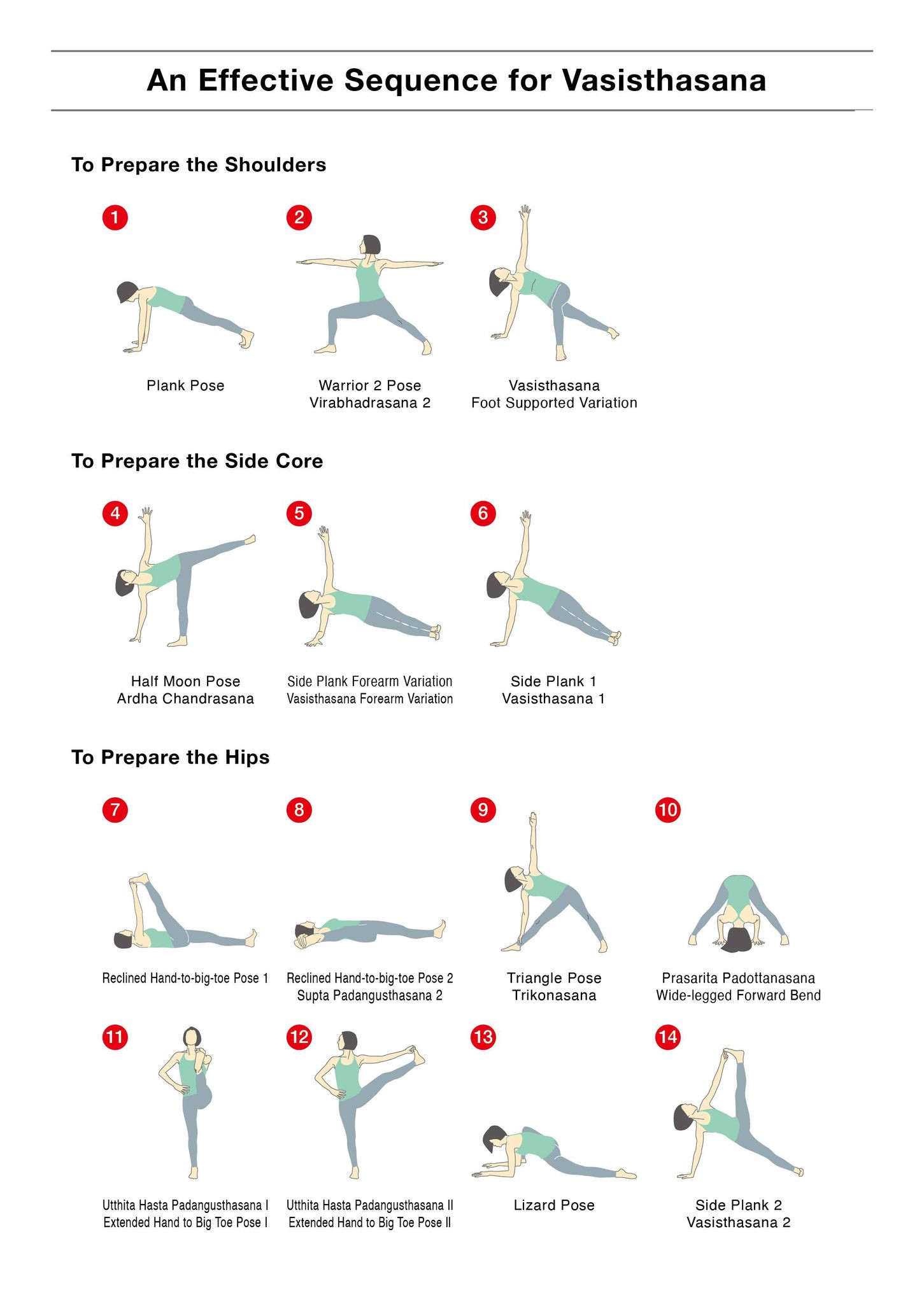Sequencing for Vasisthasana ヴァシシュターサナのためのシークエンス

ヴァシシュターサナ(サイドプランク)はヨガのアームバランスの基礎となるポーズです。さらにチャレンジングなアームバランスポーズへの足がかりとなり、練習者の体に合わせて様々なバリエーションがあります。
今までこのポーズが私のお気に入りになったことは一度もありません。ヨガを始めた頃、このポーズをする度に腕が震え、手首が悲鳴を上げていたのを覚えています。ですがこのポーズは体を安全に使う方法の詳細を多様に教えてくれました。今はこのポーズの中でもずいぶん落ち着き、バランスを見つけるために全身をどのように調整するかを身につけています。
ヴァシシュターサナには3つの主要な身体的構成要素があります。
- 肩関節
- サイドコア:腹斜筋と腰方形筋
- 内腿の筋肉群と上の脚のハムストリング
サイドコア:腹斜筋と腰方形筋
内腿の筋肉群と上の脚のハムストリング
肩関節は可動性のために作られています。安定性ではありません。私たち人間の日常生活において、肩関節は股関節のように頑丈に保つことよりも、腕と手を自由に動かせることが優先事項となります。従って肩関節の安定性は弱くなります。
ヴァシシュターサナにおいては他のアームバランスポーズと同じように肩を安定させて保つ強さが求められます。このポーズにチャレンジする前に、必ず肩関節の強化に取り組むようにしておきましょう。ヴィンヤサやアシュタンガを練習しているのであれば、プランク、チャトランガ、アップドック、ダウンドックを通る毎に肩を鍛えています。ウォーリアー2もまた、肩関節の正しいアライメントを見出しヴァシシュターサナへの準備をするのにすばらしいポーズです。
ヴァシシュターサナで骨盤を床から離して持ち上げるにはコアの中でも特にサイドコアの強さが必要となります。コアの強さを築くためにアルダチャンドラーサナ、ナヴァーサナ、サイドプランクのバリエーションの練習をしてみましょう。すると次第にヴァシシュターサナをより優雅に保つことができるようになっていきます。
ヴァシシュターサナ1を落ち着き安定して5〜10呼吸キープできるようになれば、十分に良い練習を重ね、そしてこのポーズの貴重な恩恵の大半をすでに確かに得ているといえるでしょう。ですがもしさらにダイナミックで視覚的に華やかなポーズを求めているのならば、ポーズ8〜ポーズ15を練習し、ヴァシシターサナ2の脚に向けて徐々に内腿の筋肉群とハムストリングを開いていきましょう。
ヨガの解剖学、ヨガシークエンス、ヴィンヤサヨガにさらに興味がある場合は、以下のワークショップとティーチャートレーニングの情報をチェックして下さい。
Vasisthasana, or side plank, is a fundamental arm balancing pose in yoga. It is the stepping-stone to the more challenging arm balancing poses, and it has many variations to fit the practitioner’s physicality.
It has never been my favorite pose, it’s still not. I remember when I first started yoga, my arms were shaking, my wrists were screaming every time I did this pose. But it teaches me so many details about how to use the body safely. Now I’m feeling so much more at ease and learning how to coordinate my whole body to find balance in this pose.
There are 3 primary anatomical components in this posture.
- The shoulder joints
- the side core: Obliques & QL
- The inner thigh muscles and hamstrings of the top leg
The shoulder joints are built for mobility, not stability. For us, human beings, to be able to move our arms and hands freely in daily activities is the priority, compared to keeping the shoulder joints super strong like the hip joints. Thus stability in the shoulders is compromised. Vasisthasana, like other arm balancing poses, demands extra strength to keep the shoulders stable. Make sure you work on strengthening the shoulder joints before challenging this pose. If your yoga style is vinyasa or ashtanga, you’re strengthening your shoulders every time you go through your plank, Chaturanga, upward facing dog, and downward facing dog. Warrior 2 is also a great pose to find correct alignment in the shoulder joints to prepare for Vasisthasana.
Lifting the pelvis away from the floor in Vasisthasana requires strength in the core and especially the side core. Try practicing Ardha Chandrasana, Navasana, side plank variations to build up strength in the core so eventually you can hold Vasisthasana more gracefully.
If you can hold Vasisthasana 1 with ease and stability for 5-10 breaths, I think you have done an amazing job and trust me, you have already taken away most of the valuable benefits of this pose. But if you’re looking for a more dynamic and visually splendid pose, practice pose 8 – pose 15 to gradually open up the inner thighs muscles and hamstrings of the legs for Vasisthasana 2.
If you would like to learn more about yoga anatomy, yoga sequencing, and teaching vinyasa yoga, feel free to check out my WS and TT.
Writing: Sandra Fang
Translation: HIDEMI
Illustration: Sadao Tashiro

